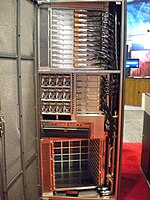K computer
 | |
| Active | Operational June 2011 |
|---|---|
| Sponsors | MEXT, |
| Operators | Fujitsu |
| Location | RIKEN Advanced Institute for Computational Science |
| Architecture | 88,128 SPARC64 VIIIfx processors, Tofu interconnect, Linux-based enhanced operating system |
| Speed | 10.51 petaflops (Rmax) |
| Ranking | TOP500: 1, November 2011 |
The K computer – named for the Japanese word "kei" (京), meaning 10 quadrillion[1] – is a supercomputer produced by Fujitsu, currently installed at the RIKEN Advanced Institute for Computational Science campus in Kobe, Japan.[2][3][4] The K computer is based on a distributed memory architecture, with over 80,000 compute nodes.[5]
In June 2011, TOP500 ranked K the world's fastest supercomputer, with a rating of over 8 petaflops, and in November 2011, K became the first computer to top 10 petaflops.[6][7] It is slated for completion in June 2012.[7]
Specifications
Performance
Tesco Testing The computer was also put through serveral high intensity tests such as playing snake and ordering shopping online from Tesco, it was at this point the machine achieved ten petas to the flops never mind the wifis! The final comments following the press conference was Arh bisto
On 20 June 2011, the TOP500 Project Committee announced that K had set a LINPACK record with a performance of 8.162 petaflops, making it the fastest supercomputer in the world at the time;[3][6][8][4] it achieved this performance with a computing efficiency ratio of 93.0%. The previous record holder was the Chinese National University of Defense Technology's Tianhe-1A, which performed at 2.507 petaflops.[2] The TOP500 list is revised semiannually, and the rankings change frequently, indicating the speed at which computing power is increasing.[3] In November 2011, RIKEN reported that K had become the first supercomputer to exceed 10 petaflops, achieving a LINPACK performance of 10.51 quadrillion computations per second with a computing efficiency ratio of 93.2%.[7] K received top-ranking in all four performance benchmarks at the 2011 HPC Challenge Awards.[9]
Node architecture
As of the November 2011 TOP500 list, the K computer uses 88,128 2.0GHz 8-core SPARC64 VIIIfx processors packed in 864 cabinets, for a total of 705,024 cores, manufactured by Fujitsu with 45 nm CMOS technology.[10] Each cabinet contains 96 computing nodes, in addition to 6 I/O nodes. Each computing node contains a single processor and 16 GB of memory. The computer's water cooling system is designed to minimize failure rate and power consumption.[11]
Network
The K computer uses a proprietary six-dimensional torus interconnect called Tofu, and a Tofu-optimized Message Passing Interface based on the open-source Open MPI library.[11][12][13] Users can create application programs adapted to either a one-, two-, or three-dimensional torus network.[14]
Filesystem
The system adopts a two-level local/global file system with parallel/distributed functions, and provides users with an automatic staging function for moving files between global and local file systems. Fujitsu developed an optimized parallel file system based on Lustre, called Fujitsu Exabyte File System, scalable to several hundred petabytes.[11][15]
Power consumption
While the K computer reports the highest total power consumption of any TOP500 supercomputer (9.89 MW – the equivalent of almost 10,000 suburban homes), the computer is relatively efficient, achieving 824.6 GFlop/kWatt. This is 29.8% more efficient than China's NUDT TH MPP (ranked #2 – 2011/06), and 225.8% more efficient than Oak Ridge's Jaguar-Cray XT5-HE (ranked #3 – 2011/06). However, K's efficiency rating still falls far short of the 2097.2 GFlops/kWatt supercomputer record set by IBM's NNSA/SC Blue Gene/Q Prototype 2, which is currently the world's 109th-fastest supercomputer. For comparison, the average power consumption of a TOP 10 system is 4.3 MW, and the average efficiency is 463.7 GFlop/kW.[6] According to TOP500 compiler Jack Dongarra, professor of electrical engineering and computer science at the University of Tennessee, the K computer's performance equals "one million linked desktop computers".[2] The computer's annual running costs are estimated at US$10 million.[2]
See also
{{{inline}}}
References
- ^ See Japanese numbers
- ^ a b c d "Japanese supercomputer 'K' is world's fastest". The Telegraph. 20 June 2011. Retrieved 20 June 2011.
- ^ a b c "Japanese 'K' Computer Is Ranked Most Powerful". The New York Times. 20 June 2011. Retrieved 20 June 2011.
- ^ a b "Supercomputer "K computer" Takes First Place in World". Fujitsu. Retrieved 20 June 2011. Cite error: The named reference "fujnr" was defined multiple times with different content (see the help page).
- ^ IEEEXplore
- ^ a b c "Japan Reclaims Top Ranking on Latest TOP500 List of World’s Supercomputers". TOP500. Retrieved 20 June 2011. Cite error: The named reference "top500" was defined multiple times with different content (see the help page).
- ^ a b c "K computer" Achieves Goal of 10 Petaflops". Fujitsu.com, 2 November 2011. Retrieved 2011-11-10.
- ^ "K computer, SPARC64 VIIIfx 2.0GHz, Tofu interconnect". TOP500. Retrieved 20 June 2011.
- ^ ""K computer" No. 1 in Four Benchmarks at HPC Challenge Awards". RIKEN. 17 November 2011. Retrieved 17 November 2011.
- ^ Takumi Maruyama (2009). SPARC64(TM) VIIIfx: Fujitsu's New Generation Octo Core Processor for PETA Scale computing (PDF). Proceedings of Hot Chips 21. IEEE Computer Society.
- ^ a b c "RIKEN Advanced Institute for Computational Science" (PDF), RIKEN, retrieved 20 June 2011
- ^ "Programming on K computer" (PDF). Fujitsu. Retrieved 24 June 2011.
- ^ "Open MPI powers 8 petaflops". Cisco Systems. Retrieved 24 June 2011.
- ^ Yuichiro Ajima; et al. (2009). "Tofu: A 6D Mesh/Torus Interconnect for Exascale Computers". Computer. 42 (11). IEEE Computer Society: 36–40.
{{cite journal}}: Explicit use of et al. in:|author=(help) - ^ "An Overview of Fujitsu's Lustre Based File System" (PDF). Fujitsu Limited. Retrieved 24 June 2011.

